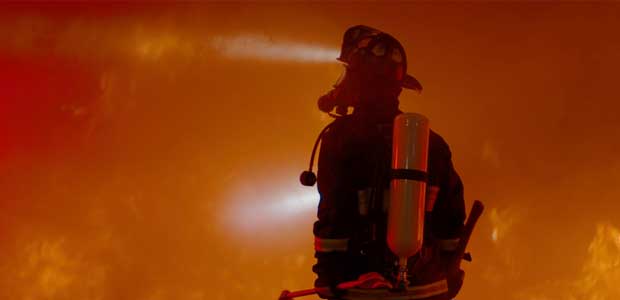
After the Fire: Are You Protected from Deadly Gases?
Because most firefighters do not carry portable gas detectors, they’re probably unaware of the danger.
- By Mike Platek
- Apr 01, 2022
When firefighters attack a structure fire, the hazards to life and health are obvious. The flames, the rolling smoke and the extreme heat are clear reminders that carelessness can lead to tragic consequences. Once the fire is extinguished, however, the operation transitions to the more routine phase of salvage and overhaul. At this point, first responders can be lulled into a false sense of security because the most serious hazard is now largely invisible—toxic gasses in the environment.
Research has shown that these toxins linger at alarming levels well after the fire has been extinguished. However, because most firefighters do not carry portable gas detectors, they’re probably unaware of the danger.
When first responders encounter fire and smoke, they wear a self-contained breathing apparatus (SCBA) to protect themselves from hazards in the air. However, even after a heavy fire is knocked down, unseen gases within the smoke will remain, keeping first responders in harm’s way.
Fire smoke is a complex mix of toxins, and hydrogen cyanide (HCN) has emerged as one of the most common and dangerous. While carbon monoxide (CO) often gets the attention, HCN is commonly found alongside it, and together, they’re known as the “toxic twins.” Both are asphyxiants, meaning they interfere with the body’s ability to process oxygen. Individually they’re dangerous. Together, they’re even more deadly.
Historically, HCN was not a concern after a typical house fire. But as the use of synthetic materials began to replace natural materials in the construction industry, HCN has become more prevalent. When heated, these fibers and petroleum-based products emit HCN at levels unseen by earlier firefighters.
The National Institute for Occupational Safety and Health (NIOSH) has determined that at 50 ppm, HCN can render someone unable to escape to safety, and thus, is immediately dangerous to life and health (IDLH). But even at much lower levels, the long-term health effects are a concern. At only 4.7 ppm, exposure should be limited to fifteen minutes per day.
While a single exposure to high concentrations of HCN is concerning, it’s the repeated exposures over a lifetime of firefighting that pose long-term harm to the human body. Each exposure damages cells, and the heart, brain and nervous system are especially prone to degradation. This is why it’s important for firefighters to monitor gas concentrations during overhaul.
Overhauls (salvage and clean up) after a fire are when most firefighters and first responders are exposed to CO and HCN. The fire is knocked down and a firefighter is looking for hot spots or fire extension, and suddenly he’s running out of air. If he decides to take off his SCBA mask, he must first check the air to make sure he’s not exposing himself to deadly gases.
CO and HCN are colorless gases and are present in the light-colored smoke left after a fire, so it’s not reliable to simply look for visual signs to determine whether these toxic gases are present.
When is it Safe to Remove an SCBA?
Considering the dangers posed by HCN, CO and other toxic gases, how do you know when it’s safe to remove an SCBA?
One solution is to train first responders to always wear SCBAs during overhaul. The problem with this approach is obvious: SCBA gear is hot and restrictive. When safety practices become a hassle, no matter how well-intentioned, people tend to ignore them.
A better solution is to don SCBA gear when atmospheric conditions require it. This means carrying a portable gas detector which will alarm when HCN, CO, or other gases rise to hazardous levels.
Luckily, it doesn’t take much time or effort to use a gas detector to identify invisible hazards.
Choosing Gas Detectors for Firefighters
Gas detectors available today are easy to use and offer advanced safety features. Connected, multi-gas monitors are often ideal for helping firefighters avoid these dangerous situations. However, many fire departments may only have one multi-gas detector per rig—or even just one for the entire department. While one monitor per department or per rig is exponentially better than no monitors at all, there are several benefits to each firefighter carrying a multi-gas detector.
Some multi-gas monitors can share alarms and gas readings between monitors. These monitors can also provide real-time location and alarm data to a central controller who can monitor the scene and dispatch additional help when necessary. These connectivity features are proven to improve your crew’s safety and awareness of their surroundings.
What does this look like in practice?
If one of your crew goes into a structure and her monitor detects a surge of gas, the rest of your crew will see the alarms on their own monitors, showing them who is in trouble and what the atmospheric conditions are—so they know exactly how to initiate the rescue.
Monitors can also be set up with customizable text messages at start up and during alarms that can provide clear safety reminders, for example, “Use SCBA when CO is above 35 ppm,” or “Wear SCBA for HCN above 5 ppm.”
Most multi-gas monitors also offer flexible configuration options thanks to interchangeable sensors, allowing for personalized coverage. Now when responding to and investigating combustible gas alarms or residential CO alarms, firefighters need only one gas detection instrument.
If multi-gas detectors aren’t part of your crew’s turnout gear, it’s time to step up your safety game.
This article originally appeared in the April 2022 issue of Occupational Health & Safety.